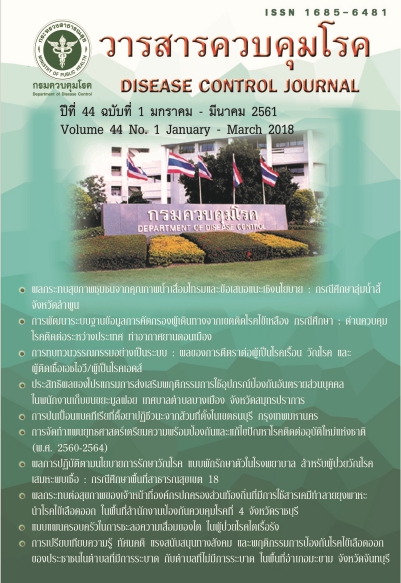Implementation of hospitalization policy for smear-positive tuberculosis patients in Public Health Region 18
DOI:
https://doi.org/10.14456/dcj.2018.7Keywords:
hospitalization policy for TB patients, , knowledge attitude practice, sputum conversion rate, Public Health region 18, ThailandAbstract
This quasi-experimental study with one group pre-test and post-test design aimed to assess implementation of the policy of hospitalization for TB patients in Public Health Region 18 by comparing their knowledge, attitude and practice (KAP) before and after the admission; evaluate their satisfaction and sputum conversion rate at the initial phase. The study populations were new, smear positive pulmonary tuberculosis (TB) cases registered for treatment at hospitals under the Ministry of Public Health in Nakhon Sawan, Kamphaeng Phet, Phichit and Uthai Thani provinces during May 1st, 2009 - July 31th, 2009. The TB KAP was provided to the patients before starting the TB treatment. During hospitalization; all doses of drug intakes were directly observed by ward nurses, TB clinic staff met the patients at the wards every day, and research team randomly monitored the treatment and adverse drug reactions. Before leaving the hospitals, health education was provided again to the patients and their relatives. After the discharging, health staff or village health volunteer (VHV) continued directly observed treatment. For cases observed by VHV, home visits every week for 2 months were performed by TB clinic staff. Research team also randomly visited the patients’ homes. Among 78 hospitalized, new smear-positive TB patients, 20.5% of the patients were admitted 1-7 days, 47.4% of the patients were admitted 8-14 days, and 32.1% of the patients were admitted more than 14 days. The average levels of KAP of the patients after the hospitalization were significantly higher than of those admitted before the hospitalization (paired t-test p-value 0.000, 0.000 and 0.019, respectively). Most of the patients satisfied with all TB services, except the patients’ food provided by the hospitals and the duration of admission. The sputum conversion rate (87.2%) was higher than the target. According to the nurses and TB clinic staff, the patients got benefits from the hospitalization as they took the medicine regularly, received close management for adverse-drug reaction and proper cares for existing complications. However, these caused much burden and financial strains to the hospital and patients’ relatives; increased the risk of TB spreading in hospital. Hospital admission should be applied only for some selected cases and other interventions such as home visit and community cares should be implemented.
Downloads
References
2. World Health Organization. Global tuberculosis control 2008: surveillance, planning, financing. Geneva: World Health Organization; 2008.
3. ปราชญ์ บุญยวงศ์วิโรจน์. สาธารณสุขกับปีแห่งการ เร่งรัดวัณโรคของไทย. กรุงเทพมหานคร: สำนักวัณโรค; 2552.
4. สำนักงานป้องกันควบคุมโรคที่ 8 จังหวัดนครสวรรค์. วิเคราะห์สถานการณ์วัณโรค 2549-2551. นครสวรรค์: สำนักงานป้องกันควบคุมโรคที่ 8 จังหวัดนครสวรรค์; 2552.
5. สำนักวัณโรค กรมควบคุมโรค กระทรวงสาธารณสุข. รายงานผลการดำเนินงานควบคุมวัณโรคของประเทศไทย ปีงบประมาณ 2549-2550. กรุงเทพมหานคร: สำนัก วัณโรค; 2553.
6. ปราชญ์ บุญยวงศ์วิโรจน์. สถานการณ์วัณโรคของประเทศไทยและแนวทางแก้ไข. วารสารวัณโรค โรคทรวงอกและเวชบำบัดวิกฤต 2551;29:169.
7. กองวัณโรค กรมควบคุมโรคติดต่อ กระทรวงสาธารณสุข. แนวปฏิบัติเพื่อสนองนโยบายสาธารณสุข ในการควบคุมวัณโรค ตามแนวทางใหม่ของประเทศไทย และ บทบาทหน้าที่ของหน่วยงานและบุคลากรที่เกี่ยวข้องในระดับเขตและจังหวัด. กรุงเทพมหานคร: ชุมนุมสหกรณ์การเกษตรแห่งประเทศไทย; 2541.
8. สำนักวัณโรค กรมควบคุมโรค กระทรวงสาธารณสุข. Training module for management of tuberculosis. กรุงเทพมหานคร: สำนักวัณโรค; 2553.
9. Baussano I, Nunn P, Williams B, Pivetta E, Bugiani M, Scano F. Tuberculosis among health care workers. Emerg Infect Dis 2011;17:488-94.
10. Bolyard EA, Tablan OC, Williams WW, Pearson ML, Shapiro CN, Deitchman SD, et al. Guide¬line for infection control in health care personal, 1998 [Internet]. [cited 2010 Oct 8]. Available from: http://www.cdc.gov/hicpac/pdf/Infect¬Control98.pdf
11. Centers for Disease Control and Prevention. The difference between latent TB infection and TB disease [Internet]. [cited 2011 Nov 4]. Available from: http://www.cdc.gov/tb/publications/ factsheets/general/LTBIandActiveTB.htm
12. สำนักวัณโรค กรมควบคุมโรค กระทรวงสาธารณสุข. แนวทางการดำเนินงานควบคุมวัณโรคแห่งชาติ พ.ศ. 2556. กรุงเทพมหานคร: องค์การสงเคราะห์ ทหารผ่านศึก ในพระบรมราชูปถัมภ์; 2556.
13. World Health Organization. What is DOTS: a guide to understanding the WHO-recommended TB control Strategy know as DOTS. Geneva: World Health rganization; 1999.
Downloads
Published
How to Cite
Issue
Section
License
Articles published in the Disease Control Journal are considered as academic work, research or analysis of the personal opinion of the authors, not the opinion of the Thailand Department of Disease Control or editorial team. The authors must be responsible for their articles.






